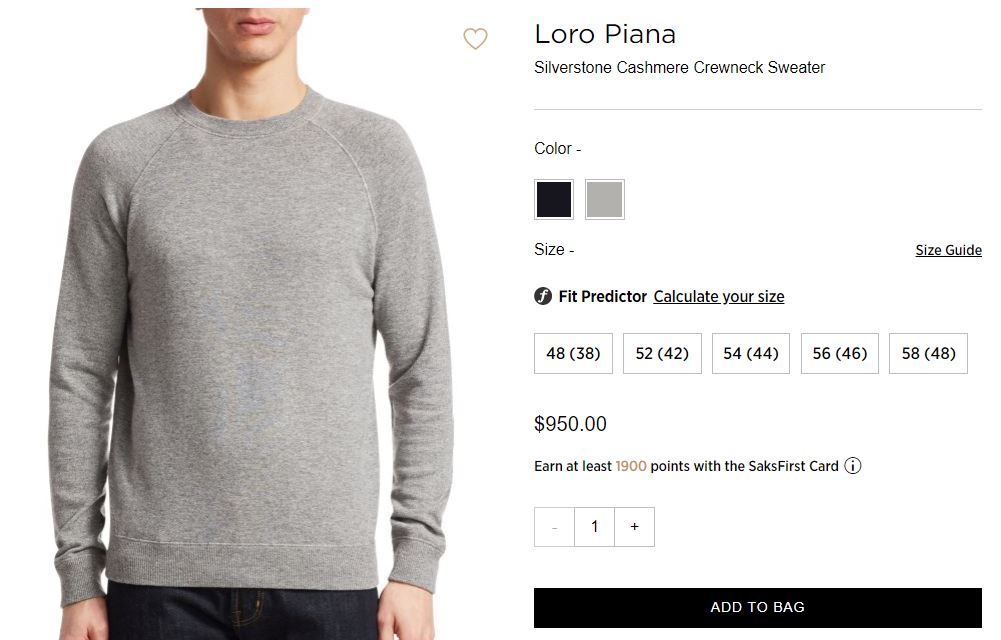Cashmere for $50 and $1500. What should I be paying?
Every summer when I was young, my mum would take me and my sisters on an annual trip to visit my American family near Boston. First stop would always be to Dunkin' Donuts and then onwards to Filene's Basement (RIP) to rifle through the steep bargains on premium items like leather accessories, designer undies (truth), and cashmere scarves and sweaters.
I don't remember what any of the actual prices were but I do know that ever since then, I've always associated cashmere with premium, luxury brands that were typically unattainable for us mere mortals. Every once in a while, my mum would treat us to a cashmere scarf at a 70% discount and, even then, it was expensive.
Fast forward twenty years and several brands - Everlane, Naadam, J Crew, Uniqlo to name a few - started launching cashmere sweaters priced well below the Cucinellis and Loro Pianas of the world. (Apparel is one of the only industries that has seen prices decline in the last twenty years. Thanks fast fashion).
Starting at just $50, you can find 100% cashmere in all sorts of styles. What gives? Why is there such a wide range of pricing for cashmere and how can we distinguish good value from ridiculous?

Cashmere is a scarce fiber produced by a certain breed of goat that inhabits extreme environments, most famously in Inner Mongolia. They grow fine hair under their bellies to keep them warm in winter and are shorn or shed once a year to extract this extra fine fiber and process it into cashmere yarn.
You need four to six goats to produce one cashmere sweater; it's a laborious and technical process that requires skillful laborers and excellent grazing conditions for the goats. As a result of these unique requirements and extreme conditions, only 0.5% of total wool production is cashmere and it is typically twice the price of wool. Here is a handy video on how cashmere is produced if you want to geek out a little harder.
There are three grades of cashmere: A, B, and C. Below that, many brands will sneak in another material to lower the cost (and quality) of the fabric such as wool. This is not cashmere, this is a cashmere blend and can be difficult to detect, especially if the brand isn't transparent about it. Which happens. The biggest difference between A, B, and C-grade is the thickness of the fibers. The thinner (finer) they are, the higher the quality and grade of cashmere.

Cashmere goats shed their coats once a year in Spring and then the extraction process begins.

Cashmere fleece takes up to two weeks to remove all the impurities and turn into cashmere yarn.
SOFTNESS DOES NOT ALWAYS INDICATE QUALITY
Contrary to popular belief, Grade A cashmere does not feel as soft to the touch as some lower grade cashmere. The softness we associate with cashmere is actually due to extra washing in the factory, a technique developed to feed Western demand for soft, soft, soft. Our supplier in China always laughs a little when we say, "But our customers need it softer, the softest you can make it". They have educated us that for durability and longevity, cashmere gets softer with time and it shouldn't be too soft or loose when you first purchase it, otherwise it will weaken and pill more quickly.
Grade A cashmere should be smooth and fine to the touch, but not fuzzy or pilling at all. When you stretch the fabric, it should bounce back quickly (indicates strength) and you shouldn't be able to see too much light come through the fabric. Over time, all cashmere will eventually pill. Sorry. Higher quality cashmere will take much longer to pill, however.

Uniqlo cashmere on sale for $49.90

Basic cashmere crewneck from Loro Piana at $990
$100 TO $300 - THE CASHMERE SWEET SPOT
Cashmere used to be very expensive because of the scarcity of the fiber. After the Asian financial crisis in the 1990s, however, prices for raw materials dropped and brands swooped in to disrupt this category.
We did some research and, in agreement with Racked, we believe that the fairest price range for cashmere that is made and procured in an ethical way, and made with high-quality yarn that will wear well and last for a long time, is between $100 and $300. That's our sweet spot for cashmere sweaters at Public Habit. Our prices are as fair as we can offer to deliver grade A cashmere from Inner Mongolia and sustain our business. We believe in paying for the best cashmere yarn and the best workmanship but we don't believe in overcharging just because we can and it's because it's Cashmere with a capital C.
Paying more than that means you’re paying extra for unique, special design, complicated workmanship, or - most commonly - a brand name. Good fabric should make up at least 60% of the total finished product cost - we believe it should be the largest component in the cost of goods next to labor for high quality, long-lasting pieces. When you're paying less than $80, we find that the cashmere is not going to be made from 100%, premium Grade A cashmere and won't stand the test of time in the way that it should.
As always, if you have questions or think we missed something, please comment below or email us at hello@publichabit.com.

